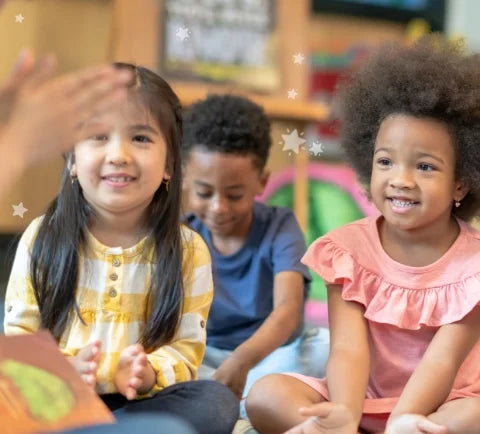What is mindfulness?
The concept of mindfulness can carry a lot of weight, but when you think about how to teach mindfulness to younger children about this concept, think of it this way: Mindfulness is being aware in the present moment.1 One way to make this easier to understand and more fun to consider for growing and curious minds is to focus on sensory things, like what you and your child are seeing hearing, and touching right now.
Mindfulness for adults often focuses on being aware of the processes of thinking and feeling, which can feel like a tall order for even the most thoughtful and open person. And it’s an even bigger task for young children who are still experiencing the world as vast and new and whose curiosity is something to encourage. That’s why starting with a sensory-based approach is key. The sensory approach doesn’t require specialized language or practices and is something that can be added to everyday activities, like walks, playtime, or even eating dinner. Rather than being preoccupied with clearing your mind, awareness can be the building block for other important social-emotional learning opportunities.
The benefits of mindfulness in family life
Not only does incorporating mindfulness at an early age help build the ability to identify when a moment might be stressful or overwhelming, it helps your young child learn to experience their thoughts without judgement.2
As a parent, you’ve surely had times when you’re abundantly aware you could have handled situations differently—maybe with less yelling or more patience. But practicing mindfulness not only gives you the ability to slow your reactions and learn to make different choices overtime, but also helps you not berate yourself for the choices you might have made in the past. Accepting that, yes, you were frustrated when you found your preschooler coloring on the wall, or when they suddenly became a picky eater and refused to eat their carrots at snack time—these are examples of mindfulness at work. Mindfulness can also help understand why you found that behavior so difficult to deal with, or why your child might have made those choices, and help you react differently next time.
If you can understand the benefits of mindfulness for yourself in parenting, imagine giving your preschooler the gift of that thoughtful awareness and attention early in their life. That gift can lead to their ability to handle stress with increased resilience as they get older—and, eventually, become parents themselves. Plus, embarking on this mindful journey together gives you precious bonding time that helps you become more in tune with each other’s needs and states of being. And ultimately, this may strengthen your relationship in a seemingly effortless way. Doesn’t that sound nice?
Mindful Activities For Your Preschooler and You
If you’re looking for inspiration, many popular meditation and mindfulness apps offer family-friendly activities and visualizations. But the best thing about mindfulness is that awareness and attention are accessible in any given moment for free. Here are some activities to try with your preschooler.
-
Deep breathing. Teach your kids this important, calming practice by placing a stuffed animal on their belly and having them watch it rise and fall. Encourage them to feel the shift in the breath by having them place their hands on their stomach and feel the pattern of up and down motions from their diaphragm.
-
Make mindful time. Suggestions for places to try this are in the car –particularly while parked or at lights—in the bathtub, on a walk, after dinner or during snack time with nutritional food and drinks like Enfagrow A+*, and during this time, make sure you’re not on your phone or devices--unless you’re using an app to help guide your mindful experience—and commit to staying uninterrupted and in the moment with your little one. Don’t panic! Mindful time can be as short as five or 10 minutes and be added onto everyday activities. 3
-
Incorporate mindfulness into learning or games you already play. Tie things like alphabet learning or number learning to observing your environment, such as “name five things that start with A” or “tell me how different types of flowers you see.” Remember, Eye Spy is the original mindfulness game.
-
Nature is a great place to connect with mindful awareness. It’s beautiful and constantly changing, but not in a way that’s hard to follow. Encourage your child to watch the clouds or feel the wind on their face and tell you what they see or feel.
-
You can begin building those emotional intelligence skills with “check-in time” where you tell each other how you’re feeling in just a few words. This helps you build in teaching your preschooler words for feelings. Even words beyond “sad” and “mad” can help you connect with each other and better understand each other’s mood at any given moment.
-
As part of a bedtime ritual, help your child work on a gratitude journal with you. Ask them what they liked about their day or how they felt about their day and write down the answers in a notebook. This can also be a great way to preserve memories of your child’s journey to adulthood, while also building reflective skills.3
By making mindfulness accessible to growing young minds, you can create an environment where both of you can feel calmer, more connected, and in control of your thoughts—but also have fun and be creative, too. So take a few minutes with your child and pay attention—you might both be better for it.
1. https://www.mindful.org/mindfulness-for-kids/
3. https://www.cheo.on.ca/en/resources-and-support/resources/P6174E.pdf
*Enfagrow is a Nutritional Supplement.





